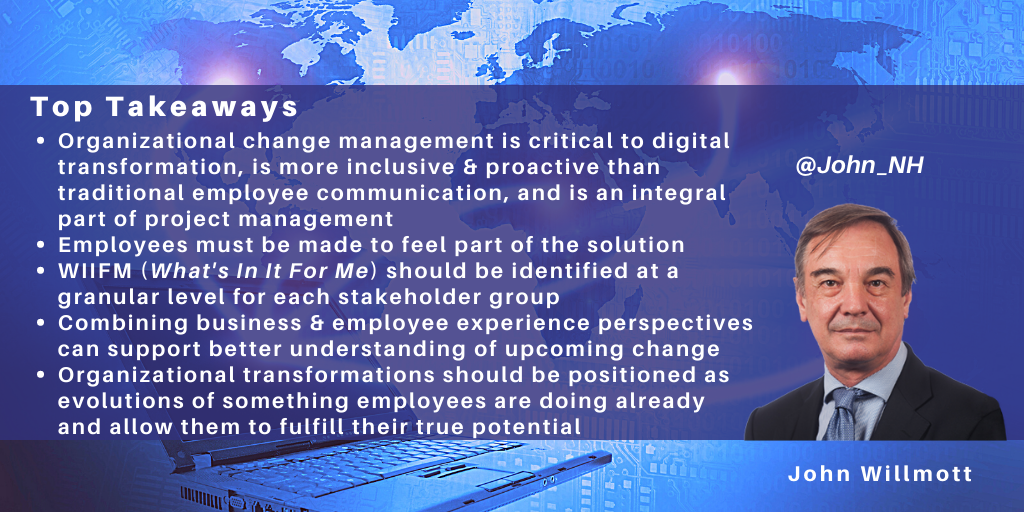Search posts by keywords:
Filter posts by author:
Related NEAT Reports
Other blog posts
posted on Feb 10, 2022 by John Willmott

Digital transformation and the associated adoption of Intelligent Process Automation (IPA) remains at an all-time high. This is to be encouraged, and enterprises are now reinventing their services and delivery at a record pace. Consequently, enterprise operations and service delivery are increasingly becoming hybrid, with delivery handled by tightly integrated combinations of personnel and automations.
However, the danger with these types of transformation is the omnipresent risk in intelligent process automation projects of putting the technology first, regarding people as secondary considerations, and alienating the workforce through reactive communication and training programs. As many major IT projects have discovered over the decades, the failure to adopt professional organizational change management procedures can lead to staff demotivation, poor system adoption, and significantly impaired ROI.
The greater the organizational transformation, the greater the need for professional organizational change management. This requires high workforce-centricity and taking a structured approach to employee change management.
In the light of this trend, NelsonHall's John Willmott interviewed Capgemini's Marek Sowa on the company’s approach to organizational change management.
JW: Marek, what do you see as the difference between organizational change management and employee communication?
MS: Employee communication tends to be seen as communicating a top-down "solution" to employees, whereas organizational change management is all about empowering employees and making them part of the solution at an individual level.
JW: What are the best practices for successful organizational change management?
MS: Capgemini has identified three best practices for successful organizational change management, namely integrated OCM, active and visible sponsorship, and developing a tailored case for change:
- Integrated OCM – OCM will be most effective when integrated with project management and involved in the project right from the planning/defining phase. It is critical that OCM is regarded as an integral component of organizational transformation and not as a communications vehicle to be bolted on to the end of the roll-out.
- Active and visible sponsorship – C-level executives should become program sponsors and provide leadership in creating a new but safe environment for employees to become familiar with new tools and learn different practices. Throughout the project, leaders should make it a top priority to prove their commitment to the transformation process, reward risk-taking, and incorporate new behaviors into the organization's day-to-day operations.
- Tailored case for change – The new solution should be made desirable and relevant for employees by presenting the change vision, outlining the organization's goals, and illustrating how the solution will help employees achieve them. It is critical that the case for change is aspirational, using evidence based on real data and a compelling vision, and that employees are made to feel part of the solution rather than threatened by technological change.
JW: So how should organizations make this approach relevant at the workgroup and individual level?
MS: A key step in achieving the goals of organizational change management is identifying and understanding all the units and personnel in the organization that will be impacted both directly and indirectly by the transformation. Each stakeholder or stakeholder group will likely find itself in a different place when it comes to perspective, concerns, and willingness to accept new ways of working. It is critical to involve each group in the transformation and get them involved in shaping and driving the transformation. One useful concept in OCM for achieving this is WIIFM (What's In It For Me), with WIIFM identified at a granular level for each stakeholder group.
Much of the benefit and expected ROI is tied to people accepting and taking ownership for the new approach and changing their existing ways of working. Successfully deployed OCM motivates personnel by empowering employees across the organization to improve and refine the new solution continually, stimulating revenue growth, and securing ROI. People need to be both aware of how the new solution is changing their work and that they are active in driving it – and thanks to that, they are actively making the organization a "powerhouse" for continuous innovation.
How an enterprise embeds change across its various siloes is very important. In fact, in the context of AI, automatization is not only about adopting new tools and software but mostly about changing the way the enterprise's personnel think, operate and do business.
JW: How do you overcome employees' natural fear of new technology?
MS: To generate enthusiasm within the organization while avoiding making the vision seem unattainable or scary, enterprises need to frame and sell transformations incorporating, for example, AI as evolutions of something the employees are doing already, not merely as "just the next logical step" but reinventions of the whole process – from both the business and experience perspective. They need to retain the familiarity which gives people comfort and confidence but, on the other hand, reassure them that the new tool/solution adds to their existing capability, allowing them to fulfill their true potential – something that is not automatable.
